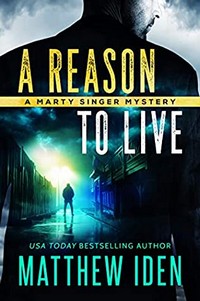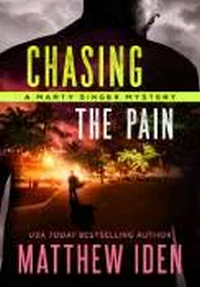 |
A Reason to Liveby Matthew Iden Kindle Edition, 312 pg. Read: August 6-7, 2021 |

Earlier this year, I read the eighth book in this series, Chasing the Pain, and enjoyed it enough that I had to go back to the first book and read the whole series.
“What’s your first move?”
“We’ve narrowed it down to Michael Wheeler or the rest of humanity,” I said. “So let’s start with Wheeler.”
What’s A Reason to Live About?
Twelve years ago, Detective Marty Singer investigated a murder. A police officer was in the home of a woman he’d been harassing and shot her. Singer didn’t believe his story and arrested him, and worked as hard as he could to put the cop away. It didn’t work, he was acquitted and then disappeared. In the ensuing years, this has haunted Marty.
Now, that woman’s daughter, Amanda, has tracked him down—she’s being stalked, harassed by someone—and all the evidence points to it being the man who killed her mom.
So she comes to the detective she learned to trust all those years ago—she needs his help to keep her alive. The downside is that Marty recently retired from the force so that he could focus on cancer treatment. But there’s no reason to tell Amanda that—Marty feels he owes her (and her mother) a debt he can’t repay, so he’ll do the next best thing—keep her alive.
The Big C
I’d been treating cancer like it was the flu, an inconvenience that I’d have to put up with temporarily. Except cancer wasn’t just a sore throat and a fever, and chemo wasn’t just a shot in the arm. Cancer wasn’t a bump in the road—it was the road, and I’d better make plans to treat it that way. My life, as I knew it, had changed for good.
Sure, there’s a murdering stalker out there, but the “Big Bad” of this novel is Marty’s cancer. It casts a looming shadow over everything, it affects the way that Marty can work—how he can investigate, protect, and defend.
I don’t know how many books will feature this struggle—I hope we get a couple more. I do know, thanks to starting the series where I did, that it’s not a constant presence in the series. I just hope that it sticks around for a bit—it’s refreshing seeing someone have to deal with things like this.
Amanda
Amanda’s face was animated, happy. I realized I wanted it to stay that way. Why? Was it feelings of guilt from a job poorly done more than a decade ago? I’d probably done worse things to more people over the years and I wasn’t hustling to make amends with them. Was it paternal? Misplaced feelings for a kid I’d never had? Maybe. But the real reason was closer at hand. It didn’t take much imagination to wonder what I’d be doing right now, how I would feel, if she hadn’t had the guts to walk up to me
It almost feels like a creepy thing for Marty to find a reason to live in Amanda, but it’s not. As he says in the quotation—it’s like he found the daughter he never had—and he gets to do something for her that he couldn’t do twelve years earlier—identify and then stop her mother’s killer.
Add in the fact that Iden made her sweet and supportive, a nice person with a good heart, and obviously, readers will get invested in her quickly and will frequently be on the edge of their seats to see if Marty can keep her safe.
So, what did I think about A Reason to Live?
And what became clear to me in that infinite moment is that, ironically, a man with cancer has more options than one that doesn’t. Having already stared my own mortality in the face, I couldn’t really be threatened with death.
When you have a thriller where the protagonist really can’t be threatened? That adds a little something
Of course, Marty’s lying to himself—there are threats that would make him stop everything—but as long as he believes he can’t be threatened, it does give him more options and adds a little something to the novel. Throw in the complications of his varying amounts of energy and stamina with the added complication of learning how to act without a badge to back him up.
Sure, some of the tension was eased because I knew the outcome for most of the characters, I knew the relationships that were being created here—just knowing that the series goes at least eight books tells you a lot right there.
Still, it was a gripping read, and a good introduction to Marty and Amanda and Marty’s retired life. A fast, enjoyable novel—it’s easy to see why the series has been going as long as it has been. You should check it out.

This post contains an affiliate link. If you purchase from it, I will get a small commission at no additional cost to you. As always, opinions are my own.
![]()





